Flowerhorn fish are fascinating pets known for their stunning looks. To keep them looking their best, it’s crucial to feed them the right food. This food should help with head growth and color. We’ll look into what makes a good diet for these fish and how it affects their health and beauty.
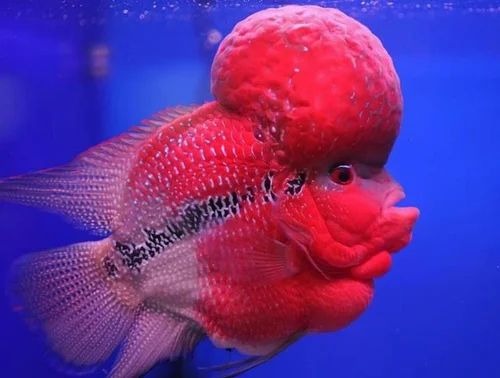
Understanding Flowerhorn Fish
Flowerhorn fish have won the hearts of many aquarium fans. They are known for their beauty and lively personalities. These traits come from a long history of ornamental fish breeding. Knowing their characteristics helps us see why they’re so popular and what they need to thrive.
History and Origin
Flowerhorn fish come from Southeast Asia. They were bred for their unique looks and traits. In many cultures, they symbolize luck and prosperity.
As their beauty and energy grew, so did their popularity worldwide. Learning about their history and breeding shows us their beauty and charm.
Physical Characteristics
Flowerhorn fish stand out with their big nuchal hump on their heads. This hump can vary in size. They also have bright colors like reds, oranges, yellows, and blues.
These colors and patterns make them a sight to behold. Their looks are key to their health and how they look.
Importance of Nutrition in Flowerhorn Fish Development
Proper nutrition is key for flowerhorn fish growth and health. A balanced diet helps them grow strong and look great. It also makes their famous nuchal hump bigger and more impressive.
Flowerhorn fish need proteins, vitamins, and minerals in their food. Proteins help with growth, vitamins keep them healthy and colorful, and minerals are good for bones and energy. These nutrients are vital for their well-being.
Choose food that’s full of nutrients and made for flowerhorn fish. This helps them stay healthy and live longer. It ensures they thrive in their home.
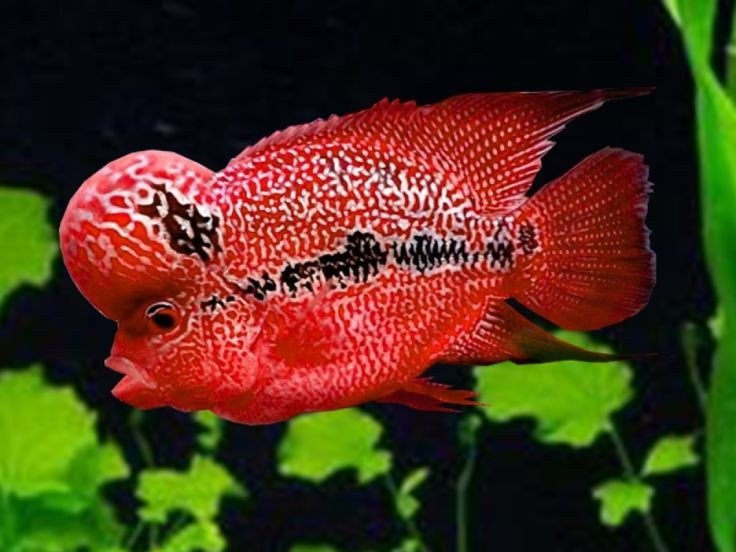
| Nutrient | Importance | Sources |
|---|---|---|
| Proteins | Supports tissue development and head growth | High-quality pellets, shrimp, and fish |
| Vitamins | Enhances immune function | Vegetables, spirulina, and commercial foods |
| Minerals | Contributes to skeletal growth and overall vitality | Fortified foods and supplements |
Give your flowerhorn fish a diet that’s right for them. This will make them happier, healthier, and more beautiful.
Best Food for Flowerhorn Fish for Head Growth and Color
Choosing the right food is key for vibrant colors and impressive head growth in Flowerhorn fish. Many options are made to boost both looks and health. Here’s a list of the best foods available.
- High-Protein Pellets: These pellets help with strong growth and keep your fish healthy. They have more protein, which is good for growing tissues.
- Color-Enhancing Flakes: Flakes with natural color boosters like astaxanthin make your fish stand out. They look more vibrant and striking.
- Freeze-Dried Options: Freeze-dried foods like shrimp or bloodworms are full of protein. They help keep your fish’s colors bright and add variety to their diet.
- Vegetable-Based Diet: Adding spirulina or algae to their diet boosts health and color. It also keeps them full of energy.
Here’s a table to help compare different food options.
| Food Type | Main Benefits | Ideal For |
|---|---|---|
| High-Protein Pellets | Supports head growth, enhances body mass | Young and developing Flowerhorns |
| Color-Enhancing Flakes | Boosts colors, contains astaxanthin | All Flowerhorns, especially show fish |
| Freeze-Dried Options | Nutritious treat, promotes natural behavior | All Flowerhorns |
| Vegetable-Based Diet | Maintains health, supports coloration | Adult Flowerhorns |
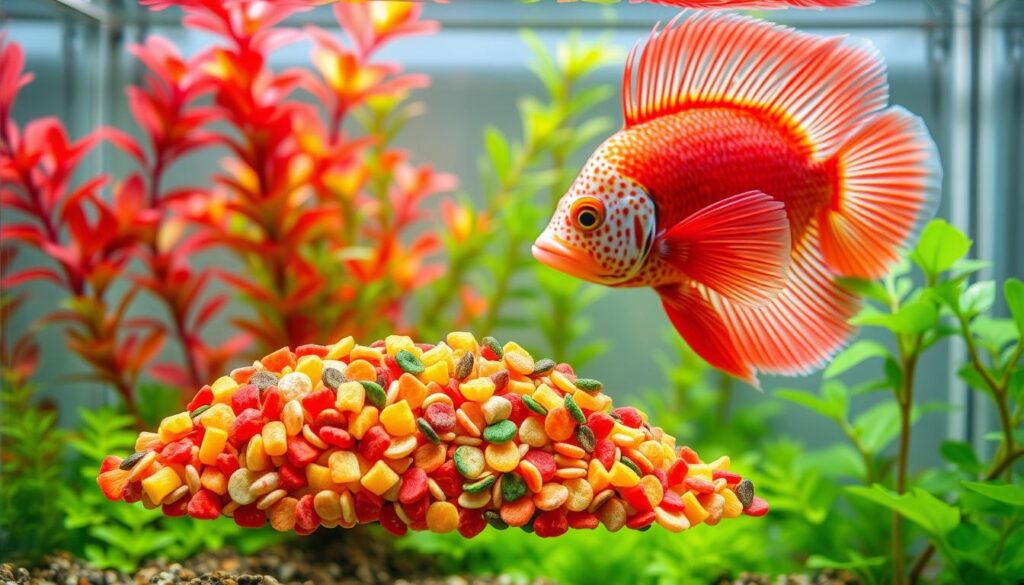
Flowers of Nutrients: What Flowerhorn Fish Need
It’s crucial to give flowerhorn fish nutrition for head development to help them grow and stay healthy. They need proteins, fats, vitamins, and minerals for their well-being.
Proteins are key for muscle growth, which is important for their head. Good sources include shrimp, worms, and special pellets. Fats give them energy and help with their metabolism. Healthy fats like fish oil and krill are great choices.
Vitamins and minerals keep their colors bright and their immune system strong. Vitamin A helps with skin health, and vitamin E boosts colors. Adding flowerhorn fish color enhancing food with carotenoids is a good idea. Omega fatty acids also help with their color.
| Nutrient | Function | Sources |
|---|---|---|
| Proteins | Builds muscle and supports head growth | Shrimp, worms, premium pellets |
| Fats | Provides energy and supports metabolism | Fish oil, krill |
| Vitamins | Enhances immune function and color | Fresh vegetables, formulated foods |
| Minerals | Strengthens bones and maintains health | Commercial supplements, mineral-rich foods |
Knowing what nutrients your fish need helps create a great environment for them. This way, they can grow and look their best.
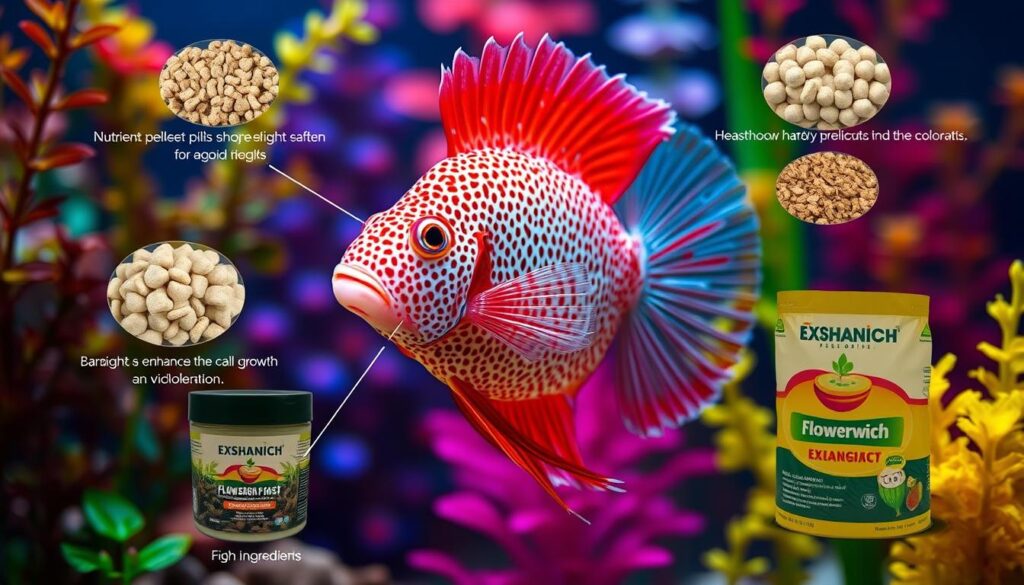
Top Food Choices for Enhancing Flowerhorn Fish Color
Choosing the right diet is key for vibrant colors in Flowerhorn fish. The top food for flowerhorn fish color enhancement should have high-quality ingredients. These ingredients boost pigmentation and often contain carotenoids.
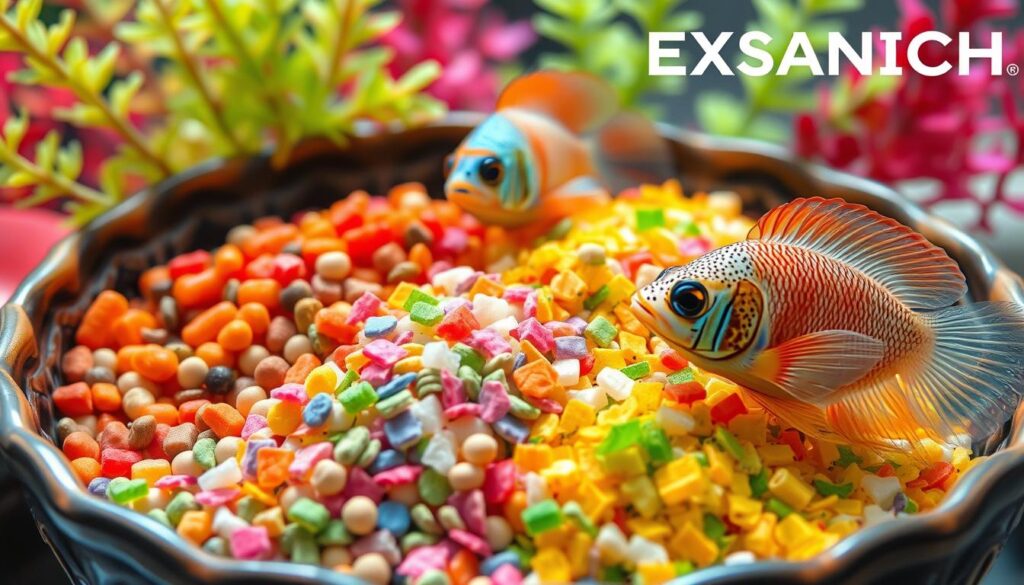
Premium brands offer special foods for Flowerhorns. Brands like Hikari and Omega One use spirulina and astaxanthin. These help improve color and keep the fish healthy and lively.
- High-quality pellets: Brands like Hikari Cichlid Gold are rich in nutrients that promote excellent coloration.
- Spirulina flakes: Ideal for maintaining vibrant colors while providing essential vitamins and minerals.
- DIY mixtures: Blend spinach, carrots, and shrimp for a homemade, flowerhorn fish color boosting diet.
It’s important to balance color enhancement with the fish’s nutritional needs. Changing their food regularly can also boost their appetite and colors.
Flowerhorn Fish Diet for Head Growth
For significant head growth in Flowerhorn fish, the right diet is key. The flowerhorn fish diet for head growth should include high-protein foods. These are rich in essential amino acids, vital for head development, especially the nuchal hump.
Feeding frequency and amount are crucial. Aim for two to three meals a day to keep growth steady. Watch the portion sizes to avoid overfeeding, which can slow growth. A focused feeding plan can greatly improve your Flowerhorn’s health and look.
- High-quality pellets formulated for cichlids
- Frozen or live foods such as shrimp or worms
- Spirulina flakes for additional nutrients
Adding these foods to your Flowerhorn’s diet can make a big difference. It can lead to a bigger and more impressive head. A balanced diet rich in nutrients is essential for their head to grow well.
Pellet vs. Flake: What’s Best for Flowerhorn Fish?
Choosing between flowerhorn fish pellets and flakes is key for your fish’s health. Each food type has its own benefits and drawbacks.
Flowerhorn fish pellets pack a lot of nutrition in a small package. They have a mix of proteins, fats, and vitamins made just for Flowerhorn fish. But, they can be messy and not all dissolve fast, leading to uneaten food at the tank bottom.
Flowerhorn fish flakes are light and float, making them easy to see and eat. They’re good for young fish that find big pellets hard to swallow. Flakes also break down fast, which helps avoid overfeeding. But, they might not have as much nutrition as pellets, which could affect your fish’s diet.
| Feature | Flowerhorn Fish Pellets | Flowerhorn Fish Flakes |
|---|---|---|
| Nutritional Value | High nutrient density | Varies, generally lower than pellets |
| Digestion | Good, when appropriately sized | Generally quicker digestion |
| Messiness | Less messy, can sink | Can create surface debris |
| Ease of Use | Convenient for structured feeding | Visible and engaging for feeding |
Homemade Diet Options for Flowerhorn Fish
Creating a homemade diet for flowerhorn fish is rewarding and good for their health. Using fresh ingredients lets aquarists make special diets for their fish. This way, the fish get better nutrition, look vibrant, and grow well.
Here are some healthy ingredients for homemade diets:
- High-quality protein sources: shrimp, fish, and lean meat are full of good nutrients.
- Vegetables: spinach, peas, and carrots add important vitamins and minerals.
- Spirulina: a nutritious algae that boosts color and health.
- Fish oil: promotes healthy fats for better growth.
To make a balanced meal, try these flowerhorn dietary recipes:
| Recipe | Ingredients | Preparation Steps |
|---|---|---|
| Shrimp and Veggie Mix | Shrimp, peas, spinach, fish oil | Cook and blend the shrimp with peas and spinach. Add a few drops of fish oil before serving. |
| Spirulina Paste | Spirulina powder, water, gelatin | Dissolve spirulina powder in hot water, mix with gelatin, pour into molds, and refrigerate until set. |
| Protein-Rich Fish Slurry | White fish fillet, carrots, fish oil | Cook the fish and carrots, blend together with fish oil until a slurry forms, and freeze in small portions. |
Using homemade diets for flowerhorn fish ensures they get balanced nutrition. It also strengthens the bond between the aquarist and their fish. By making these meals at home, owners can watch their fish thrive.
Premium Brands for Flowerhorn Nutrition
Flowerhorn fish need top-notch nutrition to grow well. The right food can make them more colorful and healthy. Here are some top brands that aquarium lovers trust for their fish’s diet.
- Hikari Cichlid Gold: This brand is known for its high protein. It helps fish grow and look vibrant.
- New Life Spectrum: Their food is made just for Flowerhorns. It has vitamins and minerals for growth and color.
- San Francisco Bay Brand: They use only the best ingredients. Their foods meet Flowerhorns’ dietary needs.
- Omega One: Their food is full of Omega-3 and Omega-6. It boosts health and color.
People love these brands. They say their fish look and grow better after trying these foods. Choosing premium brands helps keep Flowerhorns healthy and beautiful.
| Brand | Key Benefits | Protein Content | Type |
|---|---|---|---|
| Hikari Cichlid Gold | Balanced diet for growth, vibrant coloration | 36% | Pellet |
| New Life Spectrum | Essential vitamins and minerals | 34% | Pellet |
| San Francisco Bay Brand | High-quality ingredients for health | 30% | Flake/Pellet |
| Omega One | Rich in Omega fatty acids | 35% | Flake |
Feeding Tips for Vibrant Colors in Flowerhorn Fish
To get your Flowerhorn fish to show off their vibrant colors, you need to feed them right. Here are some tips to help them look their best and stay healthy.
- Feed Frequency: Feed them 2-3 times a day. This helps them digest food better and absorb nutrients, making their colors pop.
- Portion Sizes: Give them only what they can eat in 5 minutes. Too much food can harm the water and their health.
- Rotation of Food Types: Mix up their diet with pellets, flakes, and frozen foods like brine shrimp or bloodworms. This variety ensures they get all the nutrients they need for bright colors.
It’s important to check the water quality after feeding. Regular water changes and keeping the filter clean will help keep the water healthy. This lets your fish thrive and their colors shine.
| Food Type | Benefits | Recommended Brand |
|---|---|---|
| Pellets | Rich in protein and nutrients | Hikari Cichlid Gold |
| Flakes | Easy to digest, promotes color | Tetra Cichlid Floating Flakes |
| Frozen Foods | Enhances natural coloration | San Francisco Bay Brand Frozen Brine Shrimp |
By following these tips, you’ll keep your Flowerhorn fish healthy and their colors bright. This will make your aquarium a stunning sight to behold.
Conclusion
Proper care is key for flowerhorn fish to grow a big head and vibrant colors. We’ve talked about the need for a balanced diet. This includes high-quality pellets, fresh foods, and special additives.
These foods are crucial for your fish’s color and head growth. By following the best nutrition tips, you can make your fish look amazing. Remember, a good diet makes your fish healthy and beautiful.
Start this journey by learning and adjusting to your fish’s needs. Watch them closely and use what you’ve learned. This will help your fish thrive and show off their beauty.
FAQ
What is the best food for Flowerhorn fish for head growth and color enhancement?
For head growth and color, feed Flowerhorn fish high-protein pellets and color-enhancing flakes. Also, add spirulina and carotenoid-rich foods. These foods help in vibrant colors and head development.
How often should I feed my Flowerhorn fish for optimal growth and color?
Feed Flowerhorn fish two to three times a day. Use small portions to prevent waste. This keeps water quality good and promotes health and color.
Can I feed my Flowerhorn fish homemade diets?
Yes, homemade diets are nutritious for Flowerhorn fish. Use shrimp, fish, and veggies in balanced meals. This ensures they get all needed nutrients for growth and color.
What nutrients are essential for Flowerhorn fish development?
They need protein, healthy fats, vitamins, and minerals. Proteins help with muscle and head growth. Carotenoids make colors vibrant and improve health.
Are there any specific brands known for high-quality Flowerhorn fish food?
Yes, Hikari, Omega One, and New Life Spectrum are top choices. They offer premium food that supports head growth and color.
How do I know if my Flowerhorn fish is getting the right nutrition?
Healthy fish have bright colors, a big head, and are active. Dull colors, lack of appetite, or lethargy mean they might not be getting enough nutrients.
Can I mix different types of food for my Flowerhorn fish?
Absolutely! Mixing pellets, flakes, and freeze-dried foods is good. Just make sure to choose high-quality options that meet their nutritional needs.
What is the best way to enhance my Flowerhorn fish’s color?
Feed them foods rich in carotenoids, like commercial color-enhancing foods and spirulina. Regularly feeding these items can greatly improve their color over time.
How do I maintain water quality after feeding my Flowerhorn fish?
Keep an eye on feeding amounts to avoid overfeeding. Regular water changes and good filtration are key to a healthy environment for your fish.
What are some common signs of nutritional deficiencies in Flowerhorn fish?
Look out for dull colors, poor growth, abnormal shape, less activity, and swimming problems. These signs mean they’re not getting enough nutrients.

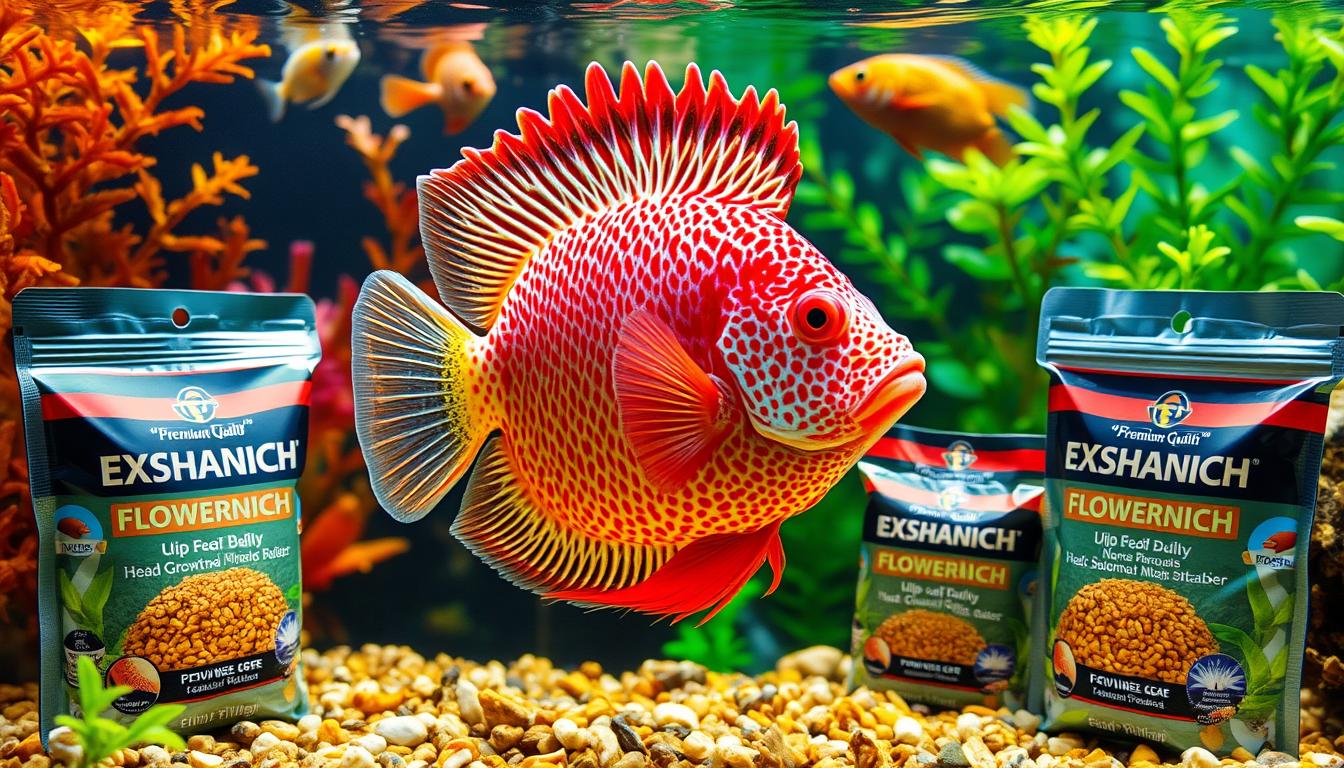


 No products in the cart.
No products in the cart.